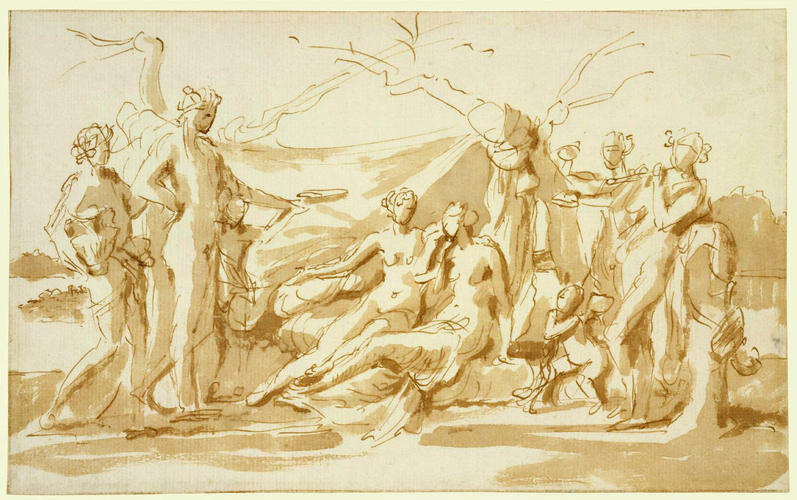Bacchus discovering Ariadne c.1634-6
Pen and brown ink, brown wash, on pink-tinged paper | 15.4 x 24.7 cm (sheet of paper) | RCIN 911911
-
A drawing of Bacchus offering a bowl of wine while a female figure seated beside Ariadne intercedes on behalf of the god; a pair of his followers play pipes and cymbals, and Cupid looks on, leaning on his bow.
Having helped Theseus escape the Minotaur's labyrinth, Ariadne's reward was to be abandoned by her lover on the isle of Naxos. She was discovered by Bacchus and his followers, received into his chariot, and shortly after they married. The literary sources differ on whether Ariadne was asleep (Philostratus, Imagines, I, 15) or awake and lamenting her fate (Ovid, Metamorphoses, VIII, 176ff) when discovered, but either reading of the present drawing is possible - with her hand to her face she could be rubbing sleep or tears from her eyes.
Another drawing for the same composition is on the verso of RCIN 911888, which shows the main group in much the same form as here,but a round dance takes place behind Bacchus and a putto plays astride a panther or leopard in the foreground.The composition was modelled in part on the celebrated Roman fresco called the Aldobrandini wedding, discovered c. 1605-6 on the Esquiline, and the borrowed motifs may explain the reluctance of some scholars to accept the subject of the drawing as Bacchus discovering Ariadne, but the numerous bacchic trappings and the informality of the scene make the identification of the episode depicted as Bacchus discovering Ariadne entirely plausible.
The composition was related by Blunt (The Paintings of Nicolas Poussin, 1966, no. 197) to a damaged painting in a private collection showing putti playing with leopards, one of which is in an pose identical to that in the rougher sketch, albeit reversed. Blunt conjectured that this was a reworked fragment of a painting of an antique wedding ceremony, identified with a nuova Nupta that was documented in the dal Pozzo collection in 1715, long after Cassiano's death. The painting does not appear to be by Poussin; but the connection with 911888v is clear, and the author of the mutilated painting may have known some more resolved version of the subject by Poussin.
Poussin's drawings of the mid-1630s were the freest and, to modern eyes, the most attractive of his career. Here, as in St Mary of Egypt and St Zosimus (911925) and the Death of Virginia (911888), he used no underdrawing before attacking the paper with pen and ink, untroubled by anatomical considerations - the arm of Bacchus's urn-bearer at far left is little more than a scribble, and the sketch on the verso of 911888 is exhilarating in the freedom of its calligraphy. Broad strokes of pale wash pull the composition together, and finally a sequence of dabs of a darker wash define the stances and gestures of the figures. The flickering pictorial effect of these final strokes distinguishes the drawings of these years; by the end of the decade the darkest accents were once again subsumed within the overall design.
A copy of the drawing by John Piper is also in the Royal Collection (RCIN 932568).Provenance
Probably Cassiano dal Pozzo (1583-1657); from whose heirs bought by Pope Clement XI, 1703; passed to his nephew, Cardinal Alessandro Albani, 1714; from whom acquired by George III, 1762
-
Creator(s)
Acquirer(s)
-
Medium and techniques
Pen and brown ink, brown wash, on pink-tinged paper
Measurements
15.4 x 24.7 cm (sheet of paper)
Other number(s)
RL 11911










